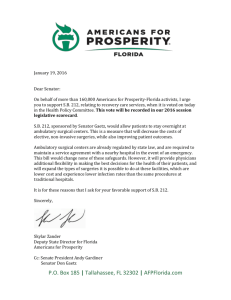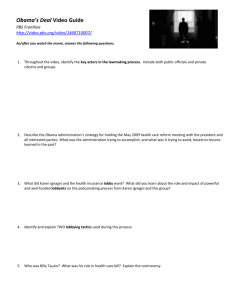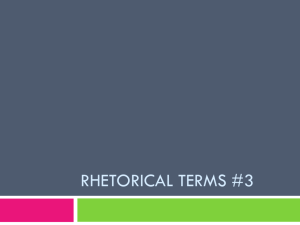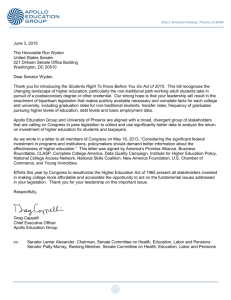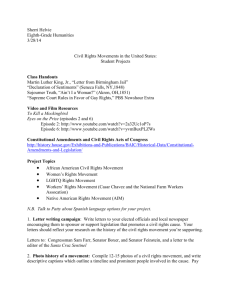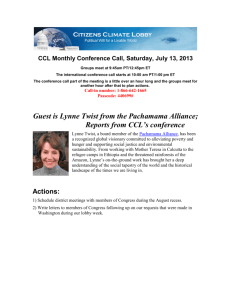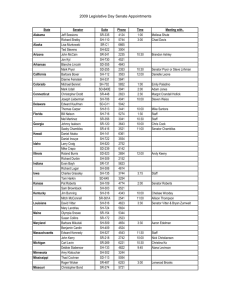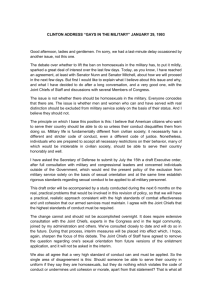State of the Union Address - Department of Social Sciences
advertisement
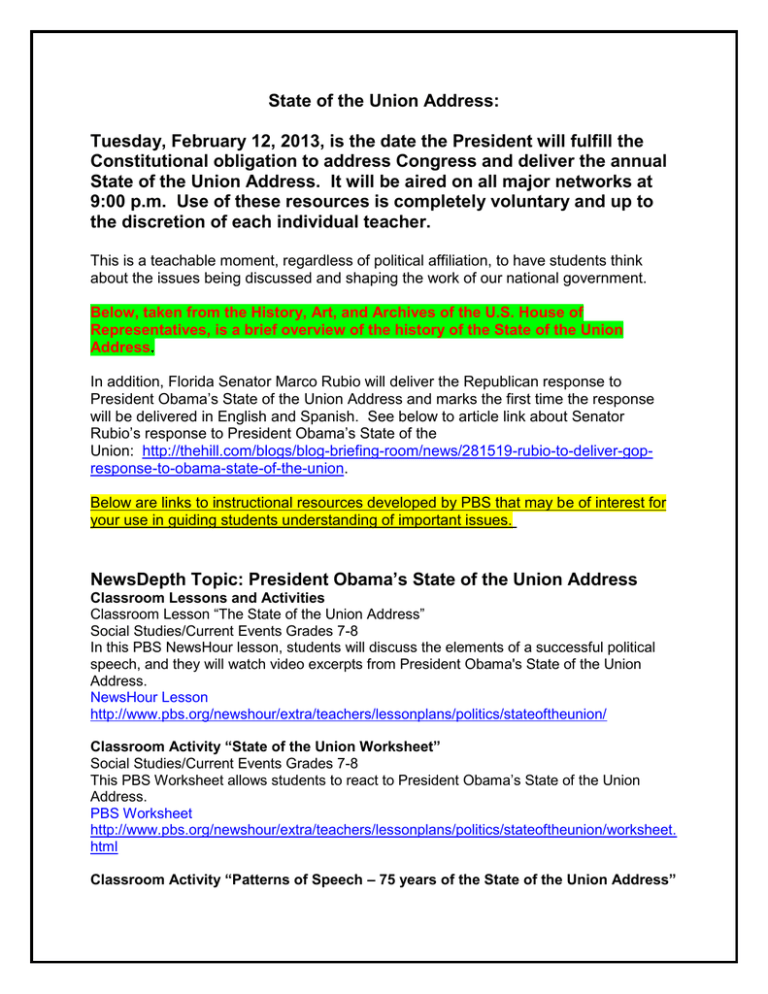
State of the Union Address: Tuesday, February 12, 2013, is the date the President will fulfill the Constitutional obligation to address Congress and deliver the annual State of the Union Address. It will be aired on all major networks at 9:00 p.m. Use of these resources is completely voluntary and up to the discretion of each individual teacher. This is a teachable moment, regardless of political affiliation, to have students think about the issues being discussed and shaping the work of our national government. Below, taken from the History, Art, and Archives of the U.S. House of Representatives, is a brief overview of the history of the State of the Union Address. In addition, Florida Senator Marco Rubio will deliver the Republican response to President Obama’s State of the Union Address and marks the first time the response will be delivered in English and Spanish. See below to article link about Senator Rubio’s response to President Obama’s State of the Union: http://thehill.com/blogs/blog-briefing-room/news/281519-rubio-to-deliver-gopresponse-to-obama-state-of-the-union. Below are links to instructional resources developed by PBS that may be of interest for your use in guiding students understanding of important issues. NewsDepth Topic: President Obama’s State of the Union Address Classroom Lessons and Activities Classroom Lesson “The State of the Union Address” Social Studies/Current Events Grades 7-8 In this PBS NewsHour lesson, students will discuss the elements of a successful political speech, and they will watch video excerpts from President Obama's State of the Union Address. NewsHour Lesson http://www.pbs.org/newshour/extra/teachers/lessonplans/politics/stateoftheunion/ Classroom Activity “State of the Union Worksheet” Social Studies/Current Events Grades 7-8 This PBS Worksheet allows students to react to President Obama’s State of the Union Address. PBS Worksheet http://www.pbs.org/newshour/extra/teachers/lessonplans/politics/stateoftheunion/worksheet. html Classroom Activity “Patterns of Speech – 75 years of the State of the Union Address” Social Studies Grades 7-8 In 2010, President Obama was the first modern president to use the words “bubble,” “supermajority” and “obesity” in a State of the Union speech. But other words have a longer history. Students will take a look at the number of times presidents have used selected words in their State of the Union addresses (or analogous speeches) from 1934 to 2011. The NY Times http://www.nytimes.com/interactive/2011/01/25/us/politics/state-of-the-union-wordsused.html?ref=stateoftheunionmessageus Classroom Activity “State of the Union Bingo” Social Studies Grades 7-8 Although the lesson was designed in 2010, it is easily adaptable to 2011. It is a tool designed to engage students in the President’s annual address to Congress, and the cards are used as a discussion starter as well as a tool to analyze the President’s agenda for the coming year. National Constitution Center Activity http://constitutioncenter.org/Files/sotubingo.pdf Classroom Lesson “Lesson for 2011 State of the Union Address” Social Studies Grades 4 Standards Included The following lesson plan can be used to help students understand President Obama's State of the Union address. State of the Union Lesson http://www.associatedcontent.com/article/6058954/lesson_plan_for_president_obamas_state.ht ml?cat=4 State of the Union Address (Information taken from History, Art, and Archives- United States House of Representatives). Including President Barack H. Obama’s 2012 address, there have been a total of 91 in person Annual Messages/State of the Union Addresses. Since President Woodrow Wilson’s 1913 address, there have been a total of 79 in person addresses. Origins and Authorization The formal basis for the State of the Union address is from the U.S. Constitution: The President “shall from time to time give to the Congress Information on the State of the Union, and recommend to their Consideration such measures as he shall judge necessary and expedient.” Article II, Section 3, Clause 1. The constitutionally mandated presidential address has gone through a few name changes: It was formally known as the Annual Message from 1790 to 1934. It began to be informally called the State of the Union address from 1942 to 1946. Since 1947 it has generally been known as the State of the Union address. Earlier Annual Messages of the President included agency budget requests and general reports on the health of the economy. During the 20th century, Congress required morespecialized reports on these two aspects, separate from the Annual Message. Budget Message, required by the National Budget and Accounting Act of 1921 (42 Stat. 20) to be delivered to Congress no more than two weeks after Congress convenes in January. Economic Report, required by the Employment Act of 1946 (60 Stat. 23), with a flexible delivery date. Over time, as the message content changed, the focus of the State of the Union also changed: In the 19th century, the annual message was both a lengthy administrative report on the various departments of the executive branch and a budget and economic message. After 1913, when Woodrow Wilson revived the practice of presenting the message to Congress in person, it became a platform for the President to rally support for his agenda. Technological changes—radio, television, and the Internet—further developed the State of the Union into a forum for the President to speak directly to the American people. Technological Change First radio broadcast of Message: President Calvin Coolidge, 1923. First television broadcast of Message: President Harry Truman, 1947. First evening delivery of Message: President Lyndon Johnson, 1965. First live webcast on Internet: President George W. Bush, 2002. First high definition television broadcast of Message, President George W. Bush, 2004. Historical Highlights The longest: President William H. Taft, 1910, 27,651 words.1 The shortest: President George Washington, 1790, 1,089 words.2 Average length: 19th century was about 10,000 words; late 20th century, about 5,000 words. Most Messages/Addresses given: President Franklin Roosevelt, 12 (10 were personal appearances before Congress). Fewest Messages/Addresses given: President Zachary Taylor, 1; President William Henry Harrison, 0; President James A. Garfield, 0. Footnotes 1 The American Presidency Project at UC Santa Barbara, http://www.presidency.ucsb.edu/sou.php (January 27, 2010). 2 Ibid. Source: History, Art & Archives, U.S. House of Representatives, “State of the Union Address,” http://history.house.gov/Institution/SOTU/State-of-the-Union/(February 11, 2013) For Additional Information Office of the Historian Office of Art and Archives B-53 Cannon House Office Building Washington, D.C. 20515 (202) 226-1300 history@mail.house.gov art@mail.house.gov archives@mail.house.gov Delivery of the Speech Fast Facts View Larger Image courtesy of Library of CongressOn December 13, 1913, Woodrow Wilson gave the first in-person Annual Message since the 18th century. President George Washington combined the Inaugural Address with his Annual Message on April 30, 1789. He read the address to a joint session of Congress in the Senate Chamber, Federal Hall, New York City. Washington delivered his first regular Annual Message to a joint session of Congress in New York City on January 8, 1790. President Thomas Jefferson began the practice of sending separate, written Annual Messages to the House and Senate, with his first one on December 8, 1801. President Woodrow Wilson revived the practice of delivering the Annual Message in person to a joint session of Congress on December 2, 1913, after delivering three special messages to Congress in person earlier in the year (tariff on April 8, currency and bank reform on June 23, and Mexican affairs on August 27). Some Presidents have sent a written Annual Message or State of the Union address rather than delivering it in person. These include Presidents Woodrow Wilson (1919-1921), Calvin Coolidge (1924-1929), Herbert Hoover (1929-1933), Franklin Roosevelt(twice), Harry Truman (1946, 1953), Dwight Eisenhower (1956, 1961), Richard Nixon(1973), Jimmy Carter (1981), and Ronald Reagan (1989). President Ronald Reagan’s State of the Union address for 1986 was rescheduled because of the Challenger disaster that took place earlier in the day. Topical Speeches Several recent Presidents have chosen not to send or deliver a formal State of the Union address during their first year in office, preferring to deliver more special messages to Congress on various policies and topics: President Ronald Reagan on economic recovery, 1981. President George H.W. Bush on “Building a Better America,” 1989. President William J. Clinton on the economy, 1993. President George W. Bush on the economy, 2001. President Barack H. Obama on the economic crisis, 2009. Two Messages in a Year In a few cases, during a transition between administrations, there have been two State of the Union messages in a single year. In these cases, usually one message is in writing while the other is personally delivered by the President before a joint session of Congress: Presidents Harry Truman (written message) and Dwight Eisenhower (address before Congress), 1953. Presidents Dwight Eisenhower (written message) and John Kennedy (address before Congress), 1961. Source http://history.house.gov/Institution/SOTU/Delivery/ The Speech: Where and When View Larger 1913 Presidential Address Gallery Pass, Collection of the U.S. House of Representatives About this object In modern practice, the State of the Union address is delivered in the House Chamber. Prior to the move to the Capitol, the Annual Message was often delivered in the Senate Chamber. A House concurrent resolution sets aside the day and time for a joint session “for receiving such communication as the President of the United States shall be pleased to make to them” and is passed by both the House and Senate. The ratification of the 20th Amendment on January 23, 1933, changed the opening of Congress from early March to early January, affecting the delivery of the Annual Message. Until 1934, the Annual Message was delivered every December. Since 1934, the Annual Message or State of the Union address is delivered every January or February. The following officials occupy floor seating in the House Chamber during the address: Members and former Members of the House of Representatives. Members and former Members of the Senate. The President’s Cabinet, save one secretary, and the Joint Chiefs of Staff. The Chief Justice of the United States and the Justices of the Supreme Court. Diplomatic Corps. Seating in the gallery is for ticket holders only and is coordinated by the Sergeant at Arms of the House. Since President Ronald Reagan’s State of the Union addresses, some of the President's personal guests in the House gallery have been publicly recognized in the course of the address. Source: http://history.house.gov/Institution/SOTU/Where-When/ Responses to the President's Message The practice began in 1966 when the television networks provided the Republican party with a half-hour slot. Senator Everett Dirksen (Republican, Illinois) and RepresentativeGerald R. Ford (Republican, Michigan) delivered the first opposition response. By 1976 the television networks were providing a slot for the opposition party almost immediately after the State of the Union address. Televised Opposition Responses to State of the Union Messages (1966Present) Year 1966 1967 1968 1969 Response Senator Everett Dirksen (R-IL) and Rep. Gerald Ford (R-MI) responded to President Lyndon Johnson’s annual message, which was delivered on January 12, 1966. The Republican response was the first organized, televised response to the annual message. Everett Dirksen (R-IL) and Rep. Gerald Ford (R-MI) responded to President Johnson’s annual message on January 10, 1967. Republican Members of Congress participated in a televised rebuttal to President Johnson’s annual message delivered on January 17, 1968. The program included comments from Rep. William Steiger (RWI), Senator Thomas Kuchel (R-CA), Rep. Gerald Ford (R-MI), Senator Charles Percy (R-IL), Rep. Richard Poff (R-VA), Rep.George Bush (R-TX), Rep. Robert Mathias (R-CA), Senator Howard Baker (R-TN), Senator Hugh Scott (R-PA), Senator John Tower (R-TX), Rep. Charlotte Reid (R-IL), Senator Peter Dominick (R-CO), Rep. Albert Quie (R-MN), Rep. Melvin Laird (R-WI), Senator Robert P. Griffin (R-MI), and Senator George Murphy (R-CA). No response. President Johnson’s annual message was delivered on January 14, 1969. President Richard Nixon’s inauguration was held on January 20, 1969. Year 1970 1971 1972 Response Democrats responded to President Nixon’s annual message on January 22, 1970, with a 45-minute televised program that included comments from Senator William Proxmire (D-WI), Rep. Donald Fraser (D-MN), Senator Mike Mansfield (D-MT), Senator Henry “Scoop” Jackson (D-WA), Senator Edmund Muskie (D-ME), Rep. Patsy Mink (D-HI), and Rep. John McCormack (D-MA). Senator Mike Mansfield (D-MT) offered the Democratic response to President Nixon’s annual message, which was delivered on January 22, 1971. Democrats responded to President Nixon’s annual message on January 20, 1972: Senator William Proxmire (D-WI), Senator Frank Church (D-ID), Senator Thomas Eagleton (D-MO), Senator Lloyd Bentsen (D-TX), Rep. Leonor Sullivan (D-MO), Rep.John Melcher (D-MT), Rep. John Brademas (D-IN), Rep. Martha Griffiths (D-MI), Rep.Ralph Metcalfe (D-IL), Rep. Carl Albert (D-OK), and Rep. Hale Boggs (D-LA). 1973 No response. Inauguration of President Nixon. 1974 Senator Mike Mansfield (D-MT) offered the Democratic response to President Nixon's annual message, which was delivered on January 20, 1974. 1975 Senator Hubert Humphrey (D-MN) and Representative Carl Albert (D-OK) provided the Democratic response to President Gerald R. Ford’s annual message, which was delivered on January 15, 1975. 1976 Senator Edmund Muskie (D-ME) provided the Democratic response to President Ford’s annual message, which was delivered on January 19, 1976. 1977 No response to President Ford’s final annual message delivered on January 12, 1977. 1978 Senator Howard Baker Jr. (R-TN) and Rep. John Rhodes (R-AZ) offered the Republican response to President Jimmy Carter’s annual message, which was delivered on January 19, 1978. 1979 Senator Howard Baker Jr. (R-TN) and Rep. John Rhodes (R-AZ) provided the Republican response to President Carter’s annual message, which was delivered on January 23, 1979. 1980 Senator Ted Stevens (R-AK) and Rep. John Rhodes (R-AZ) provided the Republican response to President Carter’s annual message, which was delivered on January 23, 1980. 1981 No response. Inauguration of President Ronald Reagan on January 20, 1981. 1 1982 Democrats responded to President Reagan’s speech delivered on January 26, 1982, with a prerecorded program televised on major networks: Senator Donald Riegle (D-MI), Senator James Sasser (D-TN), Rep. Albert Gore, Jr. (D-TN), Senator Robert Byrd (D-W.Va), Senator Edward Kennedy (D-MA), House Speaker Thomas P. O’Neill (D-MA), Senator Gary Hart (D-CO), Senator Paul Sarbanes (D-MD), Senator J. Bennett Johnston (D-LA), and Senator Alan Cranston (D-CA). Year 1983 1984 Response Democrats responded to President Reagan’s annual message delivered on January 25, 1983, with a 28minute prerecorded program. Senator Robert Byrd (D-WV), Senator Paul Tsongas (D-MA), Senator Bill Bradley (D-NJ), Senator Joe Biden (D-DE), Rep. Tom Daschle (D-SD), Rep. Barbara Kennelly (D-CT), House Speaker Thomas P. O’Neill (D-MA), Rep. George Miller (D-CA), Rep. Les AuCoin (D-OR), Rep. Paul Simon(D-IL), Rep. Timothy Wirth (D-CO), and Rep. W.G. “Bill” Hefner (D-NC). Democrats responded to President Reagan’s annual message on January 25, 1984. Senator Joe Biden (DDE), Sen. David Boren (D-OK), Senator Carl M. Levin (D-MI), Senator Max S. Baucus (D-MT), Senator Robert Byrd (D-WV), Senator Clairborne Pell (D-RI), Senator Walter Huddleston (D-KY), Rep. Dante B. Fascell (D-FL), Rep. Tom Harkin (D-IA), Rep. William Gray (D-PA), House Speaker Thomas O’Neill (DMA), and Rep. Barbara Boxer (D-CA). 1985 In response to President Reagan’s annual message on February 6, 1985, the Democratic Party provided a televised discussion among randomly selected Democratic voters. Gov. Bill Clinton (D-AR), Gov. Bob Graham (D-FL), House Speaker Thomas P. O’Neill (D-MA). 1986 Senators George Mitchell (D-ME), Lt. Gov. Harriett Woods (D-MO), Gov. Charles Robb (D-VA), Rep. Thomas Daschle (D-SD), Rep. William Gray (D-PA) responded to President Reagan’s annual message on February 4, 1986. 1987 Senator Robert Byrd (D-WV) and House Speaker Jim Wright (D-TX) responded to President Reagan’s annual message on January 27, 1987. 1988 Senator Robert Byrd (D-WV) and House Speaker Jim Wright (D-TX) responded to President Reagan’s annual message on January 25, 1988. 1989 House Speaker Jim Wright (D-TX) and Senator Lloyd Bentsen (D-TX) responded to President George H.W. Bush’s annual message. 1990 House Speaker Tom Foley (D-WA) offered the Democratic response to President Bush’s annual message on January 31, 1990. 1991 Senator George Mitchell (D-ME) offered the Democratic response to President Bush’s annual message delivered on January 29, 1991. 1992 House Speaker Tom Foley (D-WA) responded to President Bush’s annual message delivered on January 28, 1992. 1993 No response. Inauguration of President William J. Clinton.2 1994 Senator Robert Dole (R-KS) responded to President Clinton’s annual message, which was delivered on January 25, 1994. 1995 Governor Christine Todd Whitman (R-NJ) responded to President Clinton’s annual message which was delivered on January 24, 1995. Year Response 1996 Senator Robert Dole (R-KS) offered the Republican response to President Clinton’s annual message, which was delivered on January 23, 1996. 1997 Rep. J.C. Watts (R-OK) offered the Republican response to President Clinton’s annual message, which was delivered on February 4, 1997. 1998 Senator Trent Lott (R-MS) offered the Republican response to President Clinton’s annual message delivered on January 27, 1998. 1999 Rep. Jennifer Dunn (R-WA) and Rep. Steven Largent (R-OK) offered the Republican response to President Clinton’s annual message which was delivered on January 19, 1999. 2000 Senator Susan Collins (R-ME) and Senator William Frist (R-TN) offered the Republican response to President Clinton’s final annual message on January 27, 2000. 2001 No response. Inauguration of President George W. Bush.3 2002 Rep. Richard Gephardt (D-MO) offered the Democratic response to President Bush’s first annual message delivered on January 29, 2002. 2003 Governor Gary Lock (D-WA) offered the Democratic response to President George W. Bush’s annual message delivered on January 28, 2003. 2004 Senator Tom Daschle (D-SD) and Rep. Nancy Pelosi (D-CA) offered the Democratic response to President Bush’s annual message delivered on January 23, 2004. 2005 Rep. Nancy Pelosi (D-CA) and Senator Harry Reid (D-NV) offered the Democratic response to President Bush’s annual message delivered on February 2, 2005. 2006 Governor Timothy Kaine (D-VA) offered the Democratic response to President George W. Bush’s annual message delivered on January 31, 2006. 2007 Senator Jim Webb (D-VA) offered the Democratic response to President George W. Bush’s annual message delivered on January 23, 2007. 2008 Governor Kathleen Sebelius (D-KS) offered the Democratic response to President George W. Bush’s annual message delivered on January 28, 2008. 2009 No response. Inauguration of President Barack H. Obama. 4 2010 Governor Bob McDonnell (R-VA) offered the Republican response to President Barack H. Obama’s annual message delivered on January 27, 2010. Year Response 2011 Representative Paul Ryan (R-WI) offered the Republican response to President Barack H. Obama's annual message delivered on January 25, 2011. 2012 Governor Mitch Daniels (R-IN) offered the Republican response to President Barack H. Obama’s annual message delivered on January 24, 2012. Footnotes 1 President Reagan delivered a speech on economic recovery on February 18, 1981. No opposition response was offered. 2 Rep. Bob Michel (R-IL) offered the Republican response to President Bill Clinton’s Economic Address, which was delivered on February 17, 1993. 3 President Bush delivered the annual Budget Message on February 27, 2001. No opposition response was offered. 4 President Barack H. Obama delivered a message on the economic crisis on February 24, 2009. Governor Bobby Jindal (R-LA) delivered the Republican response. Source: http://history.house.gov/Institution/SOTU/Opposition-Speeches/
